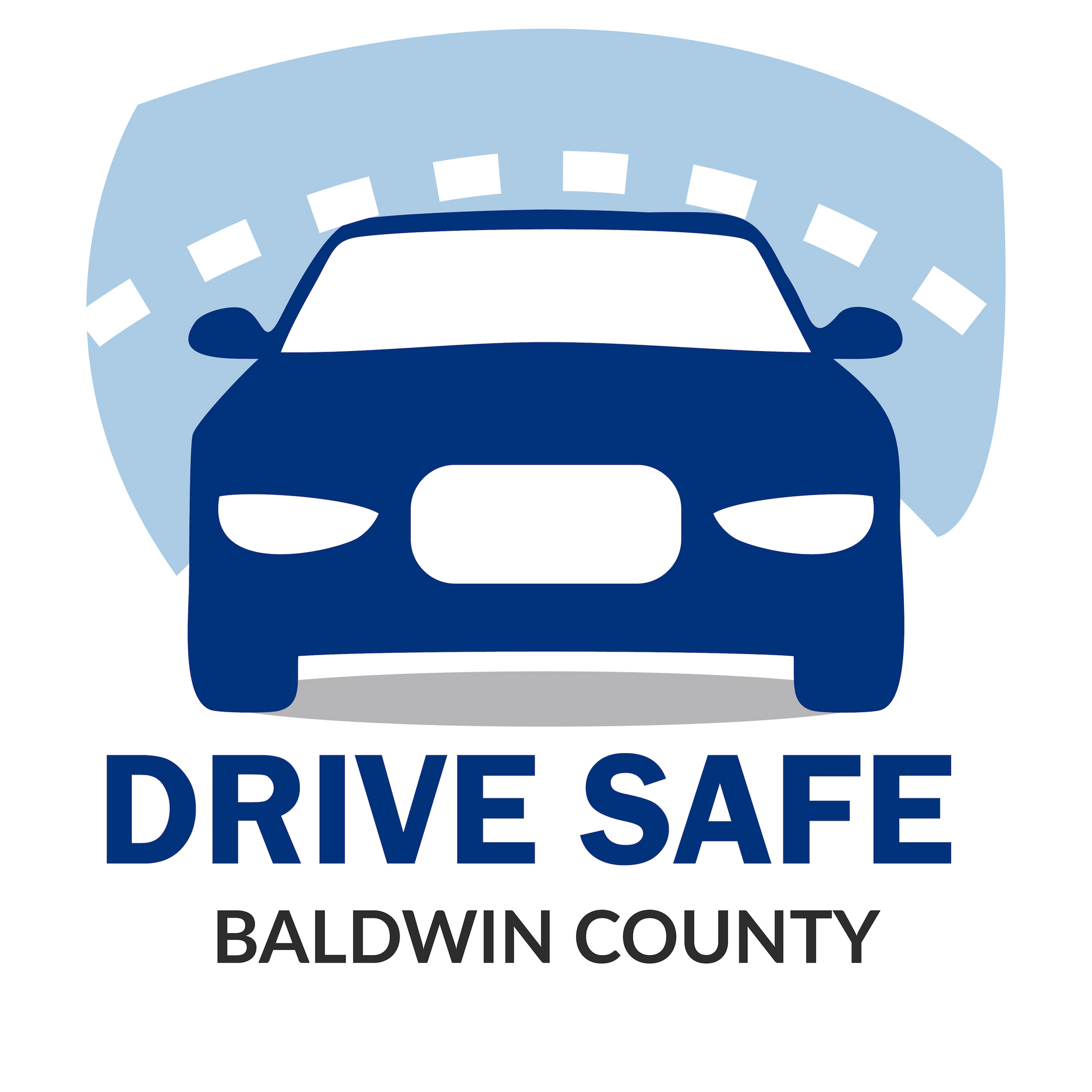Critical Driving Skills
In this section, we are not going to teach you about every sign and every light. Our focus is on the driving laws and situations that may require more thought and judgment: skills you will strengthen as you amass more driving experience. We want to give you the opportunity to discover what to expect as you gain this important experience. Again, we are explaining what you need to do when certain things happen to you on the road. It’s not a replacement for living through the experience, but if you have an idea of what can befall you on the roads, you may be better prepared for the real thing.
Stopping, Yielding, and Right of Way
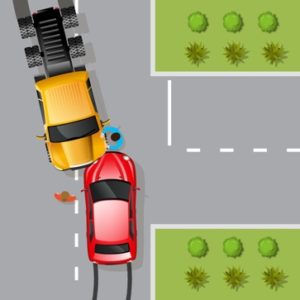
You can’t have crashes if cars don’t collide with each other on the streets. If drivers stop when they should, yield to others when they should, and respect the concept of “right of way,” crashes are kept to a minimum. Sadly, some drivers don’t stop when they should, don’t yield when they should, and don’t respect the concept of “right of way.” You learned about all of this when you learned how to drive, so how can drivers not do what they should? At this time, we will revisit the basics of stopping and yielding. Now, though, it will come with a dose of what might happen when other drivers don’t act as they should or when a situation arises that is unexpected and poses a risk to you. First up, stopping.
You will stop your vehicle thousands of times, maybe more, over the span of your driving career. So what’s the big deal? You’ll stop so much you’ll soon be able to do it with your eyes closed, right? Well before you read about what can go wrong at such a common occurrence, let’s review the characteristics of a good stop.
Any time you stop a moving vehicle, do so smoothly and gradually. Lightly hit the brake and let up. Repeat this until you slow to your desired speed or finish your gradual, smooth stop. This lets drivers around you know what you plan to do. The driver behind you will see your brake lights, and drivers off to your side or coming at you should pick up on your vehicle slowing down. Sudden jerky moves may confuse drivers to your sides and cause them to react unnecessarily. Also, if you come to too hard and sudden a stop, that driver behind you may collide with you, brake lights or not. If they were following too closely then the fault of the crash may lie with them. That doesn’t mean you might not be hurt or lose the use of your vehicle while it’s repaired. Always make your stops predictable. Make it obvious to those around you that you are slowing down and possibly stopping. Pedestrians waiting at a crosswalk will appreciate it. Drivers about to cross your path will appreciate the fact that you’ve made it obvious you are stopping at the stop sign or even at the intersection to let them pass. What kind of signal do you think it sends if you drive right to the end of a cross street or up to a stop sign and then jam on your brakes? Now you’ve got other drivers who believe you’re going to run the stop sign or shoot out into their path. They must react to what they think you are going to do. Now their reaction causes other drivers to react. At some point along this chain, there will be a driver who is too slow to react or evade. Now, we have a crash. By the way, what you are reading now concerns driving in optimal conditions. When you start to factor in darkness, heavy rain, snow, and ice, things get very dicey very quickly.

Remember, your vehicle is a machine that experiences wear and tear. What kind of wear do you think is put upon your braking system if you are constantly coming to hard stops and jamming on your brakes? Far more wear and tear than if you stop gradually the way you should. Every time you press your brake pedal there is friction between metal parts in your brakes. Keeping that friction to a minimum with smooth stops leads to longer brake life. This is obviously important to the safe operation of your vehicle. It impacts your pocketbook as well. One thing you won’t find in driver’s manuals is the cost of replacing your vehicle’s brakes or other critical parts. That’s one experience you’ll need to prepare for, especially if you’re not used to big numbers… like the kind you’ll see on your repair bill. Smooth, well controlled driving is not just about safety. You can prolong the life of many important components in your vehicle by avoiding sudden, jerky movements. The more severe a turn or a stop or an acceleration or a deceleration, the more stress and strain on your engine or other parts of your vehicle. While you won’t necessarily notice a sudden change or mechanical problem, there will be a gradual degrading of parts and systems. Then at some point, you’ll notice or feel the problem and probably end up with your car in the shop. Do your best to keep unplanned trips to the mechanic to a minimum. And that does not mean ignoring mechanical and operational problems. It means taking good care of your vehicle so you can get the level of performance you would expect and paid for.
When we get into the subject of yielding the picture gets a bit more complicated. Why? Because yielding involves more than one driver. Many times you will get to an intersection and see a sign or a light that tells you who should proceed and who should yield … slow down or stop to allow another driver to go first. That’s what yielding is all about, right? Allowing another driver or drivers to proceed before you do.

Signs or no signs, the situation will not always be clear. Normally, things should be very easy to figure out: stop if the light is red or if you have a stop sign. Let the other guy go first if you have a yield sign. But what if an impatient driver signals their intent to blow through a stop sign or run a red light. How will you recognize that signal? With experience, you will see that someone is driving far too fast given the distance their vehicle is from a stop sign or a red light. There is no way they can stop safely. Assume they’re not going to stop and prepare to brake. If they somehow bring their vehicle to a hard stop, you were at least prepared if they just kept driving. And again, prepare with a gradual stop. If you have somebody behind you, you will avoid being rear ended when you anticipate a driver running a light and you slow down gradually instead of slamming on the brakes. The worst that happens is you slowed momentarily to be sure the driver ahead of you would stop. You avoided the possible trouble ahead and the driver behind you was able to stop safely. Everyone’s happy.
The most challenging part of yielding comes when more than one vehicle arrives at an intersection at the same time. And remember, when you think “intersection,” it’s not just your standard cross shape. Anywhere that two or more roads connect is an intersection. You could have roads that meet yours directly from one side or the other. You could also have streets that gradually merge with yours, from the left or right, coming in from your rear. You need to be able to recognize when you are at an intersection and when there are other vehicles that may cross your path.
Again, in a perfect world, the driver who comes upon a yield sign will slow gradually and allow you to proceed. In the real driving world, that will not always be the case. You may encounter an impatient driver who feels they don’t have time to slow for you. In their mind, they were at the intersection first, so they can proceed. You may have a responsible driver who gets set to slow and stop; as they check their rear view mirror, they notice the driver behind them has no intention of stopping. Now that responsible driver is forced to proceed when they really don’t want to … or shouldn’t. By the way, that is something you must always check whenever you prepare to slow or stop. What is going on behind you? Does the driver to your rear have the time and room to stop without hitting you? A bit later, you will read about stopping and following distances. Maintaining a safe cushion between you and the driver to your front is a crucial factor in crash avoidance.
Have you ever seen an older style slingshot? You know, the sticks shaped like the letter Y with a rubber band across the top? Well, if you use your imagination a bit, you can see how the shape of yield a sign resembles a sling shot. A yield sign, though, is not a slingshot; it’s quite the opposite. Use this image to remind you that drivers often shoot out from a road where they should have yielded to you. Never assume every driver will respect the yield sign. Watch their speed. Watch their face or other body language. Many times you’ll need to take your cue from those and not from the sign. That’s just a sad but true piece of reality.
Yield signs can’t be placed everywhere. There are far too many intersections to put a sign at each one. Not to mention the fact that when there are so many signs in one area, they start to lose their meaning and significance; that’s the last thing we need on our roads. You probably know that, when two drivers arrive at an intersection at the same time, the driver on the right has the legal right of way. The driver on the left should yield. No sign necessary. This is a pretty standard rule. Do your best to respect it and practice it. If you do, the absence of a sign should make no difference. If it is too hard to tell who arrived at the intersection fist, back off and yield to the other driver. It is utterly senseless to get into a “me first” race. You can spare the extra few seconds you’ll spend waiting, can’t you?
(Legal) Right of Way

The concept of “Right of Way” plays a vital role in the ability for all of us to keep our roads safe. The law dictates who goes first and when in any situations where multiple vehicles and their drivers come together. In other words, if you are granted the legal right of way, you should go ahead of another vehicle you may encounter on the road. Soon when you read about intersections, you’ll get some more details regarding who is granted the legal right of way in what situations.
Now, what is it with that extra word we tacked on at the beginning? The law dictates who has the legal right of way. You should fully expect that there will be numerous times when the driver who is legally permitted to go first won’t. There are various reasons for this, most of them bad, but some of them understandable.

You already know the bad reasons: another driver is in a rush, and their time is more important than yours. Another driver is, by nature impatient and simply doesn’t want to wait for you. Another driver feels like allowing someone (who does, in fact have the legal right of way) to go first is a sign of weakness. Another driver was more focused on a new text message than on the intersection they just entered. In all of these cases, you must be the one to decide that it is safer for you to give up your right of way and allow the other driver to proceed. If you learn to read other vehicles and drivers, spotting this potential source of collisions should not be too much of a challenge. And, in case you are wondering, yielding your right of way to an inconsiderate driver is not a sign of weakness. It’s a sign of responsibility and common sense.
You may be asking yourself what a valid reason for giving up your legal right of way could be. Well, aside from letting these careless and impatient drivers go first, there are some instances where you may want to let another driver proceed even though the law gives you the right of way. A lot of it has to do with traffic. Consider this:
You approach a four way intersection just before another driver on your left does. You have the right of way and want to go straight across the intersection and continue along your route. The problem is, though, you see an eighteen wheeler up ahead on your street. It is backing into a business and has traffic stopped all the way back to your intersection. If you go now, despite having the right of way, the rear end of your car will be sticking out into the intersection obstructing other traffic. In such a case, you might want to clearly wave the other driver on.


Their route is clear and that will allow time for your path to clear up. You will run into similar situations when you approach a high school where classes have just ended and there is a line of traffic leaving the school. Or you see traffic backed up at a railroad crossing ahead so there is no room for you if you proceed. These situations will be few and far between but they do come up once in awhile. Here’s the thing: there are no lights or signs telling you what to do. So we return to the crux of this course. You must use your common sense, understanding of the law, observation skills, and good judgment to bend the rules a bit. In this case, you are not doing anything wrong. You are observing and noticing that voluntarily yielding your right of way in this one instance will keep traffic flowing and prevent obstructions to other vehicles (the back end of your car sticking out into an intersection). These types of cases while rare, will come up at some point in your driving career. No need to dwell on them but be prepared when they do. There is another old adage you may have heard: “Discretion is the better part of valor.” That adage describes this situation to a tee. Legal right of way or not, if you even think that another driver plans to get the upper hand and go when they should yield, let them pass. You will encounter many careless drivers on the road. The more distance you keep between you and them, the better.
Following and Stopping Distances

One of the most effective things you can do to avoid collisions with other vehicles is to always maintain a safe cushion between you and any drivers ahead of and around you. What do we mean by cushion? In simpler terms, always keep a safe distance between you and other vehicles. Executing a safe stop requires both time and space. If you have enough of both, you’ll stop the way you should: smoothly and gradually. This, even if a driver ahead of you jams on the brakes for whatever reason or maybe has brake lights that are out.
As a safe driver, you must be aware of three kinds of distances: following distances refer to the amount of space you should try to maintain between you and a vehicle in front of you. And while you are technically not following, lateral distance must be maintained as well. Not every crash is from the front or rear. After all, we have the term “sideswipe,” don’t we?
Stopping distance is not really something you maintain per se. It is more about the amount of space you need to bring your vehicle to a safe stop. In this case, there is no “one size fits all” number. Why? Your speed should be the first thing that comes to mind. The faster you are traveling, the more space you’ll need to slow and stop your vehicle. But there is actually more to it than just that. When you think about the time it takes you to stop, do you consider reaction time? Do you know what that is? When you see brake lights ahead or that traffic is stopped or a deer has just jumped into your path, there is a period of time where your brain tells your foot to hit the brakes. This, again, is not a set number. There are many factors that come into play. Under the best circumstances, it takes about a second and a half from the time you notice a problem to the time you begin to apply your brakes. That does not sound like a lot of time – if you are traveling at 70 miles per hour, though, it is the difference between a safe stop and a serious crash. Consider these numbers from a publication entitled Safety 1n Num3ers (yes, that is actually how it is spelled). This 2015 publication was put out by the National Highway Transportation and Safety Administration:
- If you are traveling at 55 mph, that 1.5 seconds before you brake takes you 121 feet forward from when you noticed a hazard. If the problem you saw was 300 feet to your front, you’ll stop in time. What if a child darts out in front of you only 75 feet ahead? At 55 mph, your foot hasn’t reached the brake pedal yet – and that’s if you are fully attentive.
- If the street is dry, you need another 144 feet to stop after you hit the brakes (again assuming you are going 55). On wet pavement, you’ll need 183 feet.

You might think that 55 miles per hour is a bit of an extreme example, especially where a child darts out in front of you. Sadly, this example is not extreme if you have an irresponsible driver doing 55 in a 35 mph zone. For the sake of argument, though, let’s say you are doing 30 mph. Most people would consider that reasonable; many would consider it a bit too slow. If we consider the numbers we used for our 55 mph example, we can cut them in half for this more reasonable example. That still means 1.5 seconds traveling about 60 feet before you hit your brakes. On dry pavement, you’ll need about 72 feet to stop – 91 feet if the street is wet. What are the odds of finding children along a street with a 30 mph speed limit versus 55? Probably pretty good. How much can happen along a 130 foot path if you are not paying attention? A lot, and it takes just one incident to change your life forever.
Just to give you a bit more perspective on reaction time and stopping distances, let’s consider a few more numbers from that same publication. These are under optimal driving conditions where you are paying full attention:
- At 70 mph, you’ll need a full 387 feet to react to a hazard and stop. Tractor trailer trucks need almost double that distance.
- At 40 mph, you’ll travel 88 feet before your foot hits the brake pedal.
- At 20 mph, you’ll travel 63 feet from the time you recognize a problem to the time you have stopped.
Have you ever heard the phrase, “Aim high in your steering?” Do you know what it means or how it applies to this safe driving material? Quite simply, it means don’t watch what is just to your immediate front when driving. Always be aware of what is happening up ahead. In normal conditions with normal traffic, you should always be aware of any activity from the immediate front to up to 150 feet – one city block – ahead of you. If you do this, you’ll see traffic that has suddenly stopped or the dog that ran into the street. More importantly, you should have time to slow your vehicle or bring it to a stop if needed. On more open roads and highways, you want to look up to 1/4 mile ahead. After all, at highway speeds, it takes no time at all to cover a distance of 1/4 mile. So you want to be sure everything is always clear up ahead. Remember the expression : “Aim high in your steering.” It’s important.
What about following distances? How do you judge what’s safe and what’s not? Here’s something you can try. First off, you’ll do this while you are moving, so be extremely careful. Second, your speed is an important factor you must consider. By now, you know that the faster you are traveling, the longer it will take you to safely stop (longer in both time and distance). So, in normal traffic under normal conditions, watch as a vehicle ahead of you passes some object. It can be a sign post, a mailbox, or even a streetlight. Now, count out two or three seconds. You know how that’s done, right?

One thousand one, one thousand two, one thousand three. If you pass the spot you picked out for the other vehicle before you reach two or three seconds, you are following that vehicle too closely! Ease up on the gas, and increase the space between you and the lead vehicle. In time, you won’t need to count. You’ll be able to recognize how far back is safe and how close is too close. Now, back to your speed. On highways or at higher speeds, increase the count to four, five, even six seconds. This is also true in driving conditions where roads are slick such as when covered with snow and ice. While your speed will be much lower, your stopping distance is greater because of slick roads. In such conditions you need more space to stop your vehicle safely. Do you remember about using your brakes on icy roads? In most cases, it’s the worst thing you can do. You need to tap your brakes gently, roll a bit, tap your brakes, roll, and repeat as the vehicle slows on its own. In really slick conditions, simply letting up on the gas is the best way to slow and stop – no brakes. Hitting the brakes too hard on an icy road will throw you into a skid. You can understand how you must place a great deal of space between you and a lead vehicle in these poor driving conditions. On ice, you are, in effect letting your vehicle roll to a stop on its own. If you lose control and go into a skid, you’ve got problems.
Here are some more numbers for you. Don’t get too hung up on them. We’re providing them just to give you a more detailed picture of these “following distances.” Let’s assume, for the sake of argument, that your are traveling at 45 miles per hour and you decide to count out 3 seconds to be sure you are following the vehicle ahead at a safe distance.
At 45 mph, you will travel about 122 feet in two seconds. It’s 186 for a three second count.
At 60 mph, you’ll travel 178 feet in two seconds, 264 in three.
You can see that you need a good amount of space for a cushion between you and a vehicle you follow. Just remember, though, it’s not just about the distance. We are still talking in terms of seconds. If you don’t leave yourself enough time and space to react to a hazard, you’re not going to avoid it.

So, when is two or three seconds not enough? There are many good reasons why “more is better.” First, the obvious: when road conditions are slick, you need more time and space to stop, so a five or six second cushion might be a better bet. We have already discussed that. The same will be true if you are traveling at higher speeds. Also consider your field of view? As a possibly lesser experienced driver have you followed a large truck yet? If you are behind an eighteen wheeler, you know that you see nothing ahead other than the rear end of the truck. Now, though you may not realize it, you are at the mercy of the truck driver. If that driver notices a hazard in time, then you will probably have enough time to react. But what if that truck driver does not notice a hazard or there is a sudden serious problem that occurs? If that driver has no time to react, then neither will you. On top of that, you can’t see anything other than the back of the eighteen wheeler. When following any vehicle where your view is obstructed, increase your cushion. Better yet, safely pass that vehicle if you are in a legal passing zone. Don’t take the chance that another driver is going to watch the road for you, especially when you can’t.

So, we have established that you cannot see through big trucks. The fact remains, though, that you can see under them. Whenever your field of view is obstructed by large trucks or tinted glass, look under those vehicles if possible. Depending on where you are, you might see the feet of pedestrians about to appear from behind the truck. You might see the wheels of another vehicle getting ready to pull out into your path. Be creative. If your view is completely obstructed, always proceed with extreme caution. But also look for a way that you can steal a glimpse of what is happening on the other side of larger vehicles. You’ll be surprised to discover that often times you can do it without X-ray vision. Remember this not just when you are stuck behind a truck on the road. Learn to use this skill in parking lots or when there is a truck waiting at the end of a side street. Just because you cannot see through something, doesn’t mean you can’t determine what’s happening on the other side.
Intersections
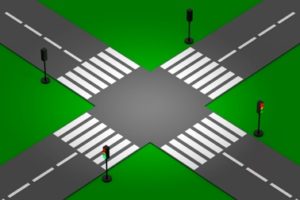
If there are ever places ripe for vehicle crashes, it’s intersections. No matter the size or how many roads converge at one spot, when you arrive at an intersection, you stand a good chance of encountering other drivers. How you … and they … behave will determine how things go.
An intersection can be anything from one road that merges into another to your classic two main roads that meet and form a cross shape in the middle of a busy city. And of course, you don’t have to stop there. In the state of Massachusetts in the town of Braintree, there is an intersection known as “Five Corners.” How many streets do you think meet there? Of course, there are signs and lights to help direct drivers, but years ago there were not. The rule of thumb back then was, “You’re on your own. Figure it out!” Rules of the road dictate proper behavior at intersections. Just remember that knowing those rules is not enough. Respect them and practice them. Recognize when other drivers at an intersection won’t.
There are two main categories of intersections: controlled and uncontrolled. A controlled intersection is one that has traffic signals and/or signs. They are in place to control the flow of traffic, hence the term “controlled intersection.” Uncontrolled intersections, as you might guess, have no traffic signals or signs to control traffic. At these intersections, drivers are responsible to determine who goes when. By the way, a controlled intersection whose traffic signal becomes inoperable is an uncontrolled intersection until the signal becomes operable again. Treat it as such unless a police officer is present to direct traffic.
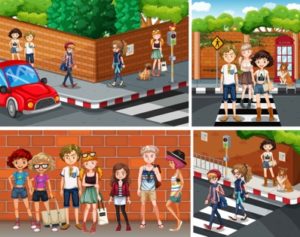
Let’s deal with controlled intersections first. On the surface, you might be thinking that there’s not much to worry about. There’s a traffic light or signs that determine who gets to proceed into and through the intersection first. But if you have the chance to observe what goes on at a busy city intersection, you’ll soon find that there is much more to be aware of:
- Pedestrians may or may not wait for a crossing light to zip across the street … walking directly into your path.
- Passenger busses may stop at intersections to pick up or drop off passengers. How do you think a stopped bus will affect your ability to see everything in and around the intersection?
- Bicyclists may enter the intersection adding to the amount of traffic you must observe.
- Other vehicles will be approaching from your rear, possibly passing you on either side and crossing in front of you on the intersecting road. Are all of those drivers observing the rules of the road and stopping when they should?
- Most of the time, you are not allowed to change lanes as you approach a multi lane intersection. Is everybody obeying that law?
- If a driver executes a turn in a multi lane intersection are they keeping within their lane or changing lanes in the middle of their turn and drifting right into the path of another driver?
There is a lot to think about as you approach a busy intersection. There is also a lot to watch for. Sure, signs or light signals direct the traffic flow, but you still have to be on your toes.

So what about uncontrolled intersections where you have no lights or signs to direct drivers? Here is where the rules of the road combined with your sound judgment is critical to the concept of crash avoidance. In many cases, you will follow the “driver on the left yields to the driver on the right” rule. As always, never assume every driver will observe that. Read other drivers. Read their vehicles. If you feel another driver is going to proceed out of turn, let them. There is no prize for winning the race to be the first through the intersection. Just remember, when you let these impatient drivers go ahead of you, be sure that you are not exposed to being rear ended by the driver behind you. Make a slow, gradual acceleration from a stop. If another driver decides they want to go first, getting back to a slow gradual stop should not be a problem if you’ve accelerated only slightly. You’ll give the driver behind you plenty of time to see that you are stopping.
Uncontrolled Intersections and Four (All) Way Stops

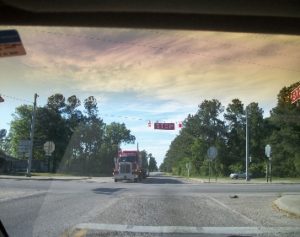
The biggest challenge you have at uncontrolled intersections is when two streets cross at right angles: in other words, your standard intersection where four roads converge. We’ll call it a “four way” or “all way.” You might know that intersections like this are treated as four way stops when multiple drivers arrive at the same time. Remember, though, there are no stop signs. Now, the big question. What to do? Remember, at four way stops, you’ve got to bend a little. First the easy part: drivers who arrive at a four way stop (or uncontrolled four way) first have the right of way to proceed first. Assuming you arrive at the same time as another driver, that driver goes first if they are on your right. You’ll go first if they are on your left. All this is, of course, after every driver has stopped at their stop sign. Typically when there are three or four drivers who arrive at the same time, you will take turns proceeding. If you can picture the intersection from above, you should all proceed in turns, going around the intersection in a clockwise rotation; this maintains that “yield to the driver on the right” idea. Once again, don’t assume everyone will wait their turn. If you are facing a driver directly across from you at a four way and you’ve both arrived at the same time, the driver going straight has the right of way over the driver planning (and signaling) to turn. If both drivers (again, directly across from each other) have signaled for turns, a right turn takes precedence and has the right of way over a left turn. And don’t forget aiming high. As you approach an uncontrolled four way or four way stop, try to get a sense of which cars have been proceeding in what order. Understand the situation before you are in the middle of it.
Executing Turns at Controlled Intersections
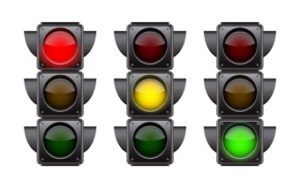
When you arrive at and plan to turn at a controlled intersection, you need to use extra care along with your common sense and good judgment. That is how you gain the experience you need to become a safe driver. While turning your vehicle is a basic skill, executing turns at busy intersections requires a bit more care and is one area where you can build some solid driving experience. While we’re talking about controlled intersections here, as soon as we factor in the element of human nature, you can’t always expect things to happen the way they’re supposed to. So before we get into the actual mechanics of turning at intersections, let’s examine the types of traffic control devices that are there to guide you as you prepare to make those turns at intersections.
As you approach a multi lane intersection, it’s possible you’ll see solid white lines painted on the pavement as you get closer to the intersection. These lines clearly mark and separate travel lanes. Why are the lines solid? To inform drivers that they should stay in their own lanes as they approach the intersection. You should completely understand that changing lanes so close to a busy spot can be downright dangerous. If you are driving in a familiar area, position your vehicle so that you’ll have safe access to the lane you need as you approach the intersection. If you are not familiar with the area, remember the “aim high in your steering” concept. Don’t wait until you arrive at the intersection to see that you need to be two lanes over to the right. Aiming high allows you to see if there are solid lines at the intersection as well as how many lanes are there. You will also be able to spot turning lanes; let’s examine those next.
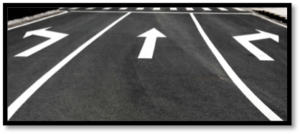
Pavement markings are also traffic control devices. So, when you see large arrows painted on the street, respect what they represent. Turning lanes do not inform drivers as to who can and cannot proceed. They do, however, tell the direction in which you can proceed. Arrows painted on turning lanes mean that the direction in which you can turn is restricted. It might be left only or right only. You might see left and straight or right and straight. Those large arrows should make things pretty clear. But again, here is where you need some experience. If you find yourself in the wrong lane … you want to turn left, but you accidentally ended up in a lane that allows you to go straight ahead or turn right … your options are straight ahead or right. After you clear the intersection, do what you must to revise your route and get back on course.
Why not simply turn left? You can drive over arrows.
There are no physical barriers, so what’s the harm?
By turning in a direction not indicated by the arrows in a turning lane, you can cause a crash. Other drivers cannot read your mind. If your vehicle is sitting in a lane marked for left turns or straight ahead only, drivers will assume you will continue in one of those directions. If you are in that lane but want to turn right, don’t. You may think that activating your right directional will solve the problem, but it only makes matters worse. Think about what drivers and pedestrians around you see: OK, there is someone sitting in a lane marked for left turn or straight only. On top of that, they have their right directional on. Those drivers can assume what they think you plan to do. Until you actually move your vehicle, though, they won’t really have a clear idea. If other drivers guess wrong or just flat out assume you will obey the turning lane arrows, the chances of a crash increase. While you may not be directly involved, drivers who misread your intentions may need to suddenly react or evade. Now they may be putting someone at risk through their actions. Now, put yourself in the other drivers’ position. What will you do if you are stopped at an intersection and see a driver sitting in a turning lane signaling to turn in a direction indicated by painted arrows…or not? The best rule of thumb is to never assume anything. Try to notice the other driver’s eyes. Where are they looking? Do you have a sense that they look concerned because they plan to turn in a direction other than the one(s) their lane allows? Do they give the impression that they will turn in a direction allowed by the arrows and indicated by their turn signal? If there is a traffic signal at this controlled intersection, delay your start by a second or two. Let the other driver move long enough so you are sure about the direction they will take. Always remember, the less you have to guess or assume, the safer your trip.
Just because controlled intersections have traffic signals, does not mean they are completely safe. Why? You know by now that every driver will not act according to the rules of the road. A red light means STOP for most people. All it takes, though, is one careless driver to run a red light for a serious life altering crash to occur. Most drivers will slow at an intersection when they see a yellow signal. They know the light’s about to turn red. Then there are those who take yellow to mean “Speed up and get through the intersection so you don’t have to wait at a red light.” These drivers whose time is apparently precious to them, also put everyone around them at risk.
That said, you may actually need to speed up at a yellow light occasionally. When a light signal turns yellow, if you are so far into the intersection that you cannot safely stop before the point that multiple roads meet, proceed through the intersection as long as it is safe to do so. Making a hard, sudden stop could leave you exposed to a rear end collision. That brings us to the second condition: when a light turns yellow, immediately check your rear view mirror. If a driver behind you is following too closely to stop safely or you see they do not plan to slow for the light, proceed through the intersection. Of course, be sure it is safe and your path is clear. Drivers like this are dangerous. In some ways, they are forcing you to choose whether you want to cause a crash out in the intersection or be rear ended by them. These careless drivers don’t have the foresight to realize what kind of trouble their actions can lead to. Don’t be one of these drivers.
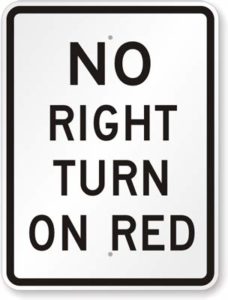
When at busy intersections, also be aware of the “right on red” rule. Remember, drivers must stop before they make the right turn. Many will not. Some will slow down and roll through their right turn. Others might make the right turn as if there were no red light at all. You need to be aware of this because their turn could take them out and across your path. The same is true if you see a “no turn on red” sign at a controlled intersection. These signs are usually in place because it’s been decided that traffic at that spot is too heavy for right turns on red. Still, drivers will make the turn. Just as with painted arrows, never assume a driver will not make a right on red because there is a sign posted that does not allow it. In this case, though, it’s not just about drivers ignoring a rule. Right on red signs are not always placed in one standard spot. You need to look for them when you approach intersections with traffic lights. Consequently, it is possible that some drivers just won’t see the signs. Before you make a right on red, be absolutely sure it’s allowed, both for other drivers and for you.
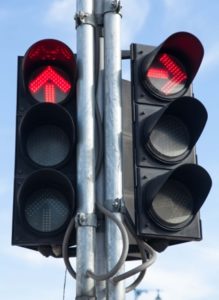
If that’s not enough, you may have to consider lighted arrows at some intersections. For the most part, they should be self explanatory. A green arrow means it’s OK to travel in the direction of the arrow as long as it’s safe to do so. Yellow indicates caution because the arrow is about to turn red. And red? Well, do you even need to ask? This brings up an important concern, though. If a red arrow is like a red light, then you can go right on red as long as there is no sign prohibiting it, correct? Unfortunately, that answer is not an easy one. Right turn on red arrow laws differ from state to state. Not only that, they can differ in towns and cities within a state! In this particular case, experience won’t help you. In Alabama, the language of the law seems to indicate that a right turn after stop on red arrow is OK. But the language is pretty vague, so unless you know for sure it is OK, you may be best to wait for the red arrow to turn green. When in doubt, it may be worth it to assume the answer to “right turn on red arrow” is no.

Whenever you make what you consider standard turns at an intersection, there are important things to consider in some cases. We’re not talking about watching for other traffic, pedestrians, or cyclists. Depending on the number of travel lanes on the road you turn from and the road you enter, there are things you need to know. Before we get into specific turns, at specific intersections, consider the “lane drop.” A lane drop simply means that the number of lanes on a stretch of road will decease … drop. Typically, the number of available lanes drops by one and a sign or light panel will give you sufficient warning. Things get dicier, though, when you are in the middle of executing a turn at a multi lane intersection. Driving in a familiar area, you know that soon after you complete your turn, the number of travel lanes drops from two to one. But what if you are not expecting that. As you complete a turn with a driver in the adjacent lane, the lead driver should, of course, have the right of way. Yield to them. If your vehicle is almost at the same point as the other, let up on the gas and let the other driver take the lead. They should do the same for you, but again …can you complete the thought? Maybe they will and maybe they won’t. Keep a close eye on their vehicle and try to determine if they are bound to get ahead of you before the lane drop. If taking the lead is that important to them, let them go. While you’re at it, try to allow for as much distance as you can between you and them. Who knows what else they may be up to?
Now, let’s consider these different scenarios that you are sure to encounter:
Left Turn From a One Way Street to a One Way Street
- As you approach the intersection, be in the far left lane, closest to a curb line or median.
- When you have a green light or arrow, execute your smooth, gradual turn after you see that your path is clear.
- You want to enter your new road in the same far left lane: closest to the curb or median.
- If you started out in a turning lane – second lane from the left – that is the lane you want to enter when you complete your left turn. Watch for lane drops.
- If the one way street you are on has more than one lane for left turns, stay in your own lane! Changing lanes in the middle of a turn is a sure way to cause a collision.
- One final point: In many states, this is the one and only time you can legally make a “left turn on red” after stop. Alabama allows “left on red” in this instance …only.
Left Turn From a One Way Street to a Two Way Street
- As you approach the intersection, again, you’ll want to be in the far left lane closest to the curb line or median. If there is a turning lane marked for left turns, you can enter that as well.
- Once the signal permits, check your path and execute your smooth, gradual turn.
- You are about to enter a street with two way traffic. You want to be in the left lane closest to the lane with traffic flowing in the opposite direction, so watch for yellow lines or medians that mark the road. If you started in a turning lane, you want to end up two lanes from the flow the traffic going in the opposite direction.
- As always, stay within your own lane throughout the turn and watch for lane drops on your new road.
- When turning onto a road with two way traffic, you’ll actually turn from a point further out in the intersection. Otherwise, if you turn too early, you will turn into oncoming traffic.
Left Turn From Two Way Street to a One Way Street
- Upon your approach at the intersection, be sure you are in the far left lane, closest to oncoming traffic.
- If there is a turning lane, enter it and start your turn from there if you’d like.
- When your path is clear enter the intersection and execute your turn. In this situation, you must yield to oncoming traffic.
- Enter the lane on the one way road that matches the lane you just vacated: far left to far left or second from left to second from left.
- Stay in your lane throughout the turn.
- Be aware of lane drops on your new road.

In General, You’ll Follow the Same Guidelines for Making Right Turns.
- Start out in the far right lane or in a turning lane if there is a right facing arrow on the pavement.
- Regardless of the number of lanes or direction of traffic on your new road, turn from far right to far right or second from right to second from right.
- Check that your path is clear and execute your smooth, gradual turn.
- Stay in your own lane from start to finish.
- Be aware of lane drops after you enter your new road.
- Special right turn concerns!!! Check the right side of your vehicle before turning right. Watch for cyclists or motorcycles that may be approaching you from behind. You could inadvertently enter their path while making your turn. Even if you are ahead, don’t assume they will yield to you.
- Never swing wide left to complete a right turn. You may pull out into the path of a vehicle approaching from behind you.
- Stay close to the curb line (unless you are in a turning lane) but don’t cut the corner too early. You will end up “jumping the curb.” That may not go over well with your passengers nor with people along the side of the road.
Always be sure to check your path in all directions. Watch for other traffic and pedestrians and cyclists and anything else that can affect the way you drive. And, of course, you should always have your appropriate turn signal activated regardless of the kind of intersection you are in.
One Final Thought About Turns and Intersections: Large Trucks and Buses
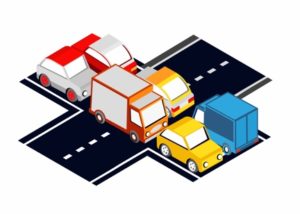
Trucks and buses require more space on the roads. This is especially true when they make turns at intersections. Once in awhile, you may see stop lines painted well before an intersection. This is to allow enough space for a larger vehicle to make a turn into that street. This type of situation is more likely to occur in more populated, metropolitan areas; in time, however, you will absolutely experience it. Painted lines or no lines, always be aware of the traffic around you at intersections. If you are sitting at a red light and see that an eighteen wheeler on your left plans to turn down your street, stay back. Doing so will give that larger vehicle the space it needs to make the sharp corner of a right angled turn. If you are too far forward (in most cases like this, you are not doing anything wrong), the truck driver will have to delay the turn, causing a traffic problem. Next time you see that a large vehicle wants to turn down your street, stay back to allow space for the truck and watch as the driver gives you an appreciative wave.
Signaling
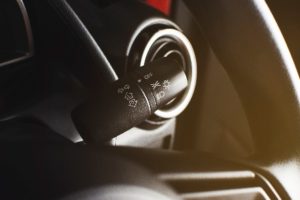
In this section, you won’t learn the basic rules about using your turn signals. Here, you need to understand how experience and keen observation skills are critical out on the roads – this, even when drivers are obeying the rules governing the use of turn signals.
Imagine yourself sitting at the end of a street and waiting to pull out into busy, moving traffic. About one hundred feet up on your left, a vehicle approaches and the driver has activated that car’s right turn signal. Between that driver and you are two driveways and a side street. Seeing that the driver has activated the right turn signal, what is your next move? Do you pull out into traffic? Do you wait for a bit? Experienced drivers, when faced with such a situation will consider a number of important factors:
- Does the vehicle seem to be slowing as it approaches the driveways or the side street as if to prepare for a turn?
- Does the driver of the other vehicle appear to be looking in the direction of the planned turn?
- Are there driveways and/or side streets located to your right? In other words, will the driver proceed past your position before turning?
- Might the driver be unaware that the turn signal did not reset itself after an earlier turn?
- Is the driver of the other vehicle focused on the path straight ahead indicating (s)he may not be planning to turn?
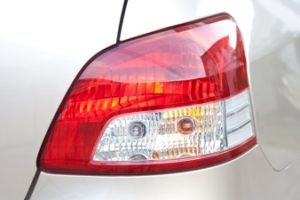
Sometimes, following the turn signal rules to the letter can actually be more dangerous. You should obey these rules as much as possible, but take into consideration the conditions present when you want to make a turn and activate your signal:
- If you are approaching drivers who appear to be waiting to pull out in front of you, are there side streets, store entrances, or driveways between you and them?
- Are you planning to turn at one of those side streets?
- Is your turn coming up after you pass the driver who is waiting to pull out?
- Is another driver following closely behind you to where you need to signal early to avoid being rear ended?
This is a real dilemma. Signal too early and the driver ahead may assume you are turning and pull out in front of you. Signal too late and you may have to slow down more quickly than you want to leaving yourself open to being hit from behind. It’s a real tightrope walk. When you find yourself in this situation, assess your options. If your turn is past the driver up ahead but before the suggested turn signal distance (anywhere from 50 to 100 feet before your turn), signal a bit later. Start to slow down very gradually so the driver behind you can maintain a safe distance. Hold off on your turn signal until you are almost upon the waiting driver. If you do this, there is no way that driver should think you are turning before them. This situation is less than ideal, but you are stuck trying to let two drivers know your intentions: the driver ahead of you and the driver behind you. If either one guesses wrong, there may be a crash. With time and experience, you will become very good at both reading and sending your intentions to other drivers when you are making turns in congested areas.
“I had no idea I was in his blind spot!”

We cannot end a discussion on signaling (nor passing as you’ll read about next), without considering blind spots. You already know not to rely solely on your mirrors when you want to turn or change lanes. Why? Blind spots. Due to the physical shape of your vehicle’s mirrors, there are areas around your car that you will not be able to see; you’ll be blind to those spots. Typically, your blind spots are at the rear quarters of your vehicle and off to the sides. Should you change lanes or turn without looking over your shoulder first, you could very likely drift into the path of a vehicle behind you. Blind spots can also be created by the structure of your vehicle. Many times, there is framework separating your rear window from your side windows in the back. If another vehicle – or pedestrian – is positioned directly between you and this framework, you won’t notice it. This, by the way can occur even if you do look over your shoulder first. Know your vehicle and know it’s blind spots. And don’t forget that blind spots are there even when you are backing up. Don’t rely just on your mirrors to check behind you.
Nowadays, it is possible to purchase blind spot mirrors. They are inexpensive and a great investment. You apply them by simply affixing them to your clean side mirrors. Be careful, though. While these mirrors give you a wider field of view, they distort distances. You may see a vehicle behind you and to your right which appears far behind you. It probably isn’t.

Blind spots are a two way street. After all, if someone is in your blind spot, isn’t it possible for you to be in someone else’s? Of course it is. If you are traveling on a multi lane road with travel in one direction, avoid trailing a vehicle off to its side and even with (or a little behind) its rear quarters. This is especially true when you follow large trucks on highways. If a driver does not use the same level of care that we want you to use when changing lanes, they may pull into your lane suddenly not having seen you in their blind spot. Now you are forced into making an evasive move. On multi lane roads, especially higher speed freeways, this could cause you to drag other drivers into your emergency. Just remember this: another driver’s blind spot is not blind to you. Recognize them and stay clear of them.
Passing Slower Vehicles
You are probably not surprised that the subject of passing is included in this course. While a fairly common move in driving, it is also one of the most dangerous. Before we get into the nitty gritty of this topic, it is important to define the meaning of “slower vehicle.” We will start out by telling you what it is not.
A “slow vehicle” is most definitely not a vehicle traveling slower than you want it to because you have some place to be.

Many crashes, some fatal, occur because impatient drivers pass vehicles that they don’t need to or shouldn’t have passed in the first place. When drivers attempt to pass such vehicles, everything in the process must happen more quickly because the vehicle is not going too slow. In some cases and with really impatient drivers, the vehicle being passed might actually be exceeding the speed limit! Once you start to consider vehicles like this as traveling too slowly, you open yourself up to unnecessary risks.
As you have learned, speed limits are not assigned without research and data. So the speed limit signs you see posted mean something. In today’s fast paced world, drivers often get the feeling they have pulled up behind a slow driver. But a quick check of the speedometer reveals that the driver up ahead is traveling at the posted speed limit.
While technically you have no reason to pass this vehicle, sometimes it’s OK. Other times, it’s actually a good idea and a safer option. On freeways and highways, speed limits are, of course, in force. Sometimes, though, you need to keep up with the “flow of traffic.” If most vehicles are traveling over the speed limit – not seriously speeding but exceeding the speed limit by a bit – you will probably be better off if you maintain a similar speed to those other vehicles. If you stay at the posted limit, you could actually be obstructing traffic. How come? Because in a place where everybody is traveling 65 and you are doing 60, you become a “slow” driver. Now, most vehicles who approach you will pass you. More passing means a better chance of some sort of mishap.

Passing a large truck or other vehicle is also a wise choice, even if that truck is traveling at the posted speed limit. Why? Remember, if you are behind larger vehicles, your field of view is severely restricted, especially if you are following too closely. In such a case, you are much better off passing that vehicle so you can regain the field of view you need to operate safely. Remember too, that all of this is assuming you are in an area where passing is legal. If it is not, then the decision is made for you – NO PASSING. Just leave more room between your vehicle and the truck.

One critical skill you need as a safe and experienced driver is to be able to judge how long it will take a vehicle to get from point A to point B. In this particular case, we refer to vehicles that are coming at you. This skill is important not just in the context of passing, but also for pulling out into moving traffic. If you are ready to pull out onto a main road and believe an approaching vehicle will reach you in 5 seconds but they get to you in 3 … well, you can probably guess what happens. Whenever you pull out into traffic or pass vehicles and have to briefly pull out into oncoming traffic, other drivers are coming right at you. Don’t forget, by the way, this is also true when you are waiting to make a left turn at an intersection with two way traffic. Pull out too late and you’ll be hit. Pull out with just enough time, and you force an oncoming driver to slow their vehicle if not jam on the brakes. It is critical that you can judge safe distances. You must know if you can proceed safely without causing other drivers to slow, or worse, make an evasive move. By the way, this is a great time to introduce the idea of being decisive. Never pull out into traffic unless you are sure you can do so safely, with time and distance to spare. Once you make that decision, always stick to it! Pulling half way out into an intersection or into or out of a parking lot and then stopping to rethink your decision is dangerous.
Commit to your decisions but don’t move an inch until you know you’ve made the correct one – the safe one.

When you are waiting to pull out into moving traffic and your little brother and sister are in the car with you, the stakes are higher – much higher. Know how much space and time you have before attempting to enter and merge with moving traffic. Always err on the side if caution. If you are unsure, assume other vehicles will reach you earlier than they will. Oh, and one more thing: YOU are the driver and YOU make the decisions. If you pull out into traffic at the wrong time, you will be involved in the crash, not the guy behind you leaning on his horn because he is late for an appointment. Don’t let impatient drivers throw you, horn or not. You go when you determine it is safe to proceed. Unless you are in a panic and are literally holding up traffic because you are petrified about pulling out (that is another whole subject for another time. Rethink whether you are ready to drive), you proceed when you feel it is safe. The driver behind you is subject to the same rules as you are. Now, back to passing.
For the purposes of this course, we will cover passing situations that are not so cut and dry. In all of the cases we will discuss, let’s assume that you have checked your path – including looking over your shoulder and not relying just on your mirrors – and have signaled as appropriate. But here’s where good judgment and experience will come into play.
First off, remember the importance of solid pavement lines. Solid, white or yellow, means no passing. Sometimes you will find yourself on a stretch of road with a solid line. Unfortunately, you are behind a mail delivery vehicle or a cyclist. And it looks like they will not turn off your road anytime soon. Maybe there is a car pulled to the side of the road with mechanical issues.
This is a very tricky situation, because the law varies depending on the state you are operating in. Many states require anywhere from a two to four foot cushion between you and a cyclist on the road. Sometimes, maintaining that cushion requires you to cross a solid line. But here’s where you must be extra cautious. If that solid line is yellow, you are pulling out into oncoming traffic. So, regardless of how slow the cyclist is going – and the guy behind you laying on the horn – do not pass the cyclist unless you are absolutely sure you have the time and space to safely do so. If the solid line is white, then check behind you. Moving into an adjacent lane separated by a white line means you could cut off a driver behind you. Front or rear, a crash is still a crash.

The situation is a lot less clear when you have, say a mail truck or a farm tractor. In Alabama as in other states, mail or delivery trucks or parked vehicles are considered “obstructions.” Sometimes, you must cross over the center line of the road to get past them.
If you pass such vehicles you need to use extra care. Again, make sure you have enough time and space to pass. Yield to oncoming traffic. Remember also, it is easy to see around and ahead of a bicycle. If you need to pass a slow moving or disabled vehicle, that is not the case. At the very least, your vision will be partially if not fully obstructed. Have you ever tried to look through a trash hauler truck? When you move to pass an obstruction, ease left, ever so slightly to get a glimpse of what, if anything, is up ahead. If things look clear, ease out a bit more so you can see more … all the while making sure to keep a safe distance from the bike or truck or whatever you are passing. Once you see the path appears clear, make your move to pass. Then, get back into your lane as quickly and safely as possible. Recall, that means being able to see the entire front of the vehicle you just passed in your rear view mirror before you get back into your original lane. Finally, remember this: a slow moving vehicle is not an obstruction. You must be sure that you are passing a vehicle that is obstructing traffic and not one that is just driving slowly.
Regardless of whether you are in a passing zone or a no passing zone, remember the conditions where you should not attempt to pass a slower vehicle:
- First off, oncoming traffic is present, and you know for sure that they are too close for you to execute and complete a safe pass.
- There is an intersection or side street ahead and you cannot tell if other vehicles are present there.
- You are close to the crest of a hill and cannot see if traffic is approaching from the other side.
- You are close to a bridge or overpass that prevents you from seeing the oncoming traffic.
- You have any doubt whatsoever about the speed of an oncoming vehicle and when they will reach you. Remember, you are both driving towards each other. Also note that it is very difficult to judge the speed of motorcycles because of their smaller size. Keep this in mind, not just when passing but when waiting to turn at intersections.
- At night. Avoid passing slower vehicles after dark if at all possible. It will be, of course, much more difficult to judge the presence of oncoming traffic in lower light conditions – or if the oncoming driver has not yet activated their headlights.

Just remember, avoid passing other vehicles if it’s not necessary. Ask yourself if a vehicle ahead of you really is traveling slowly or if you are just being impatient. Take a pass on passing when you know you shouldn’t.
